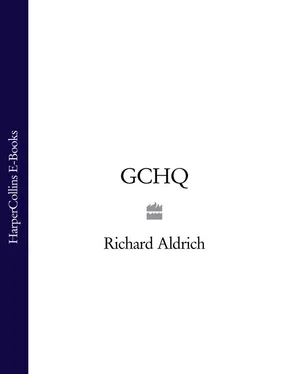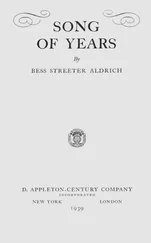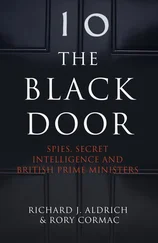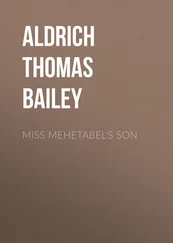Relations with the Australians were somewhat awkward. Typically, London had reluctantly agreed that Sir Frederick Shedden, the new Australian Defence Minister, could be indoctrinated into the secrets of sigint, but only so he could use his power to prevent a reduction of Australian spending on intelligence. There had also been alleged leaks about intelligence in Canberra, and in September 1945 there were momentary doubts as to whether any cooperation with Australia on sigint would be authorised. 11 Indeed, by December 1945 a ‘dangerous position’ had developed, with the Australians seeming to want to go it alone with their own system; what was worse, there were rival elements within the Australian armed services. British liaison officers warned, ‘If we are not prompt to give a lead there may even be 3 or 4 rival shows in Australia with no hope of proper security.’ During the war, material collected in Australia and the Far East had often been sent back to Britain for analysis. However, there was now a possibility that the Australians might end up ‘insisting on full exploitation in Australia’. This was a situation that British code-breakers wanted to avoid at all costs, since final exploitation was power, and they wished to keep their Commonwealth associates in a subordinate position. 12
The crucial moment in the creation of the global sigint alliance occurred on 22 February 1946, when Britain opened a two-week Commonwealth conference for ‘Signals Intelligence Authorities’. This gave them critical mass prior to concluding a deal with the Americans the following month. The attendance of Australia and Canada was a foregone conclusion, and given the significant contribution that New Zealand had made during the war to naval sigint, there were hopes that she would also join in. 13 The conference was also attended by senior officers from GCHQ’s regional centres. Bruce Keith, the commander of HMS Anderson, the massive sigint collection station in Ceylon, was there, accompanied by his deputy, Teddy Poulden. 14 At this conference Australia offered sixty-five operating teams, amounting to 417 personnel, from the three armed services as its contribution to a new global sigint network. 15 Australia was persuaded to set up a British-style Joint Intelligence Committee and, most importantly, a unitary Signals Intelligence Centre along the lines of GCHQ, which was given the cover name Defence Signals Branch. 16
The big issue was the choice of the director of Australian sigint. The Australians fielded four candidates, all experienced wartime intelligence officers. However, Travis told them bluntly that it would be a British officer. Some Australians were affronted, but on balance Travis’s decision was probably correct, since it ensured that Australia would have good access to British sigint. Travis’s choice was Teddy Poulden, who had spent the last two years of the war as deputy to Bruce Keith, the commander of HMS Anderson, on Ceylon. 17 Poulden took over in April 1947, commanding a staff of around two hundred, about twenty of whom were GCHQ personnel on secondment. Although senior Australian sigint officers resented the fact that Poulden had his own private cypher for communicating with Travis, he was broadly considered to have done a good job. In the early 1950s he was succeeded by an Australian, Ralph Thompson, who remained in the position until 1978, making him easily the longest-serving Western sigint chief. 18 In January 1947 a further Commonwealth sigint conference was held in London, and the Chifley government gave final approval for the integration of Australian sigint into UKUSA at the end of the year. 19 However, this was delayed by the security concerns raised by Venona, so there was little sigint contact between Australia and the United States until 1949. 20
Canada’s sigint organisation under the long-serving Lieutenant Colonel Edward Drake suffered similar ‘colonial’ treatment. Although Drake was a Canadian, his deputy was the stalwart British code-breaker and expert on Russian systems Geoffrey Stevens, who arrived to take up his post in Ottawa in March 1946. A few weeks later, on 13 April, the Canadian Prime Minister Mackenzie King authorised the consolidation of a number of wartime organisations into a small post-war unit of about a hundred staff known as the Communications Branch of the National Research Council (CBNRC). A number of senior posts were filled by staff seconded by GCHQ, prompting locals to observe that CBNRC stood for ‘Communications Branch – No Room for Canadians’. By the late 1940s Drake had resolved to offset this British oligopoly by developing better relations with the US Army code-breakers. 21
The two-week sigint conference that GCHQ had convened with the Commonwealth partners in February 1946 was a vital prelude to business with the Americans the following month. 22 Indeed, the Australians and Canadians had given GCHQ permission to negotiate on their behalf. 23 On 6 March, William Friedman, one of the US Army’s most senior code-breakers, arrived in London to complete a revised version of the previous wartime agreements between Britain and the United States. The main section of the agreement which followed this policy conference between the principals was only four pages long; however, a UK-USA Technical Conference followed in June 1946 which added many annexes and appendices. Much of this new material was about attempting to agree on security procedures for handling sigint. 24 The terms of the 1946 agreement are still highly secret. Both parties agreed to ‘pool their knowledge of foreign comint organizations’, and that in any future negotiations with other parties ‘every effort should be made to avoid disclosure of US/UK collaboration in the COMINT field’. 25 Joseph Wenger, the head of America’s naval code-breakers, accepted that the 1946 conference had only dealt with generalities, and this had generated ‘some criticism’. Nevertheless, his priority was to ‘set up the framework and establish the will to make it work’, so in his view it was a great success, and ‘laid the foundation of a very fruitful and important partnership’. 26
For GCHQ, liaison with allies was all-important to its new status as a proper intelligence agency in its own right. By the spring of 1946, Edward Travis was operating with two deputies at Eastcote. Nigel de Grey was the senior deputy, and had responsibility for operational coordination between the five main groups at GCHQ, together with recruitment, training and security. Following the important allied sigint conferences of February and March 1946, Travis added a second deputy, a naval officer called Captain Edward Hastings who had much wartime experience of working with Canada. His responsibilities included liaison with the US, the Commonwealth and India, together with managing GCHQ’s overseas collection stations. 27
GCHQ’s strategy for cooperation with the Americans was to rapidly reorientate its collection towards Russia. Typically, the vast Forest Moor wireless station near Harrogate in Yorkshire, with an aerial farm of some ten square miles, was switched from collecting German traffic from the Eastern Front to Russian traffic as soon as the war drew to an end. British field units in Germany, Austria and Italy joined the suborned Italians in collecting Russian military traffic. The re-established sigint stations in Singapore and Hong Kong also focused on Russian traffic, with the latter specialising in KGB messages. All this made Britain an attractive partner for the United States. 28 The core of Anglo-American cooperation was a ‘relentless attack’ on the wartime generation of Russian cyphers. Figures like John Tiltman and Hugh Alexander provided the code-breaking expertise, while the Americans provided most of the processing capability. 29
All the three American armed services were routinely circulated with GCHQ finished product on Russia. A key instrument was the ‘Comintsum’, a digest of the latest ‘hot’ material which made its way around comint-cleared centres. London would send twenty copies of this sort of document to Washington on a regular basis, with two copies going to US Air Force intelligence, two to US Army intelligence and so forth. 30 On Russian military targets at least, the British and Americans operated smoothly as one machine. A very high priority was given to joint planning for the use of nuclear weapons in any future war. As early as 28 April 1948, General Charles Cabell, head of US Air Force intelligence, reviewed the intelligence arrangements in support of the current emergency atomic strike plan ‘Operation Halfmoon’. ‘At the present time,’ he noted with satisfaction, ‘there is complete interchange of communications intelligence information between the cognizant United States and British agencies. It is not believed that the present arrangements…could be improved.’ 31 This was cemented by a further Anglo– American agreement on communications intelligence signed in June 1948.
Читать дальше












